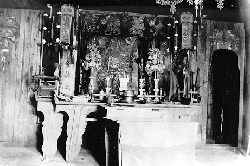Chinese immigrants in Virginia City
Updated: August 21, 2020

The history of Virginia City is rich with ethnic and cultural diversity. Gold was the magnet that brought settlers from around the world to the Rocky Mountains. Immigrants from many countries settled the area. Among the first to arrive were the Chinese, who came during Montana's early territorial years.
Most of the Chinese that reached the Montana Territory emigrated from the Kwangtung Provence of China, which includes Hong Kong. Poverty, overpopulation and political turmoil had been the reasons for leaving their Far East homeland. Like their European counterparts, most were poor and landless in China. America's natural resources and an opportunity for a better life first drew them to California. As gold strikes dwindled in California, miners including the Asians moved inland to follow fresh strikes in the territories of Colorado, Idaho, and Montana.

America was known as "Gum San," the Land of Golden Mountains, to the Chinese trying to escape the harsh conditions in their own country. When they arrived, they provided the labor needed to do the backbreaking work of mining and railroad construction as well as providing services the miners were reluctant to do, such as laundry and domestic work.
For the most part Asian immigrants left their families at home. In 1870, the Chinese population of Montana was 1,949 (nearly ten percent of the total population), but only 123 were female. Virginia City was home to 500 to 1,000 Chinese miners. The Chinese brought with them similar backgrounds, social structure, languages, and experiences that allowed them to endure the many hardships of the Montana frontier and in many cases to prosper.

Photograph Archives. Material may be protected by
copyright law (Title 17 U.S. Code)
The miners worked for the Chung Wah Kung Saw or the Chinese Six Companies, somewhat like a guild or secret society. Many also belonged to the Chinese Masonic Lodge. The Chinese miners built a Chinatown at the lower (east) end of Wallace Street. At the entrance to Chinatown was a two-story temple named the Joss House, which served the religious needs of the Asians and also provided a social meeting place. The Chinese kept secret the internal workings and leadership of their organizations. The organizations helped to define a code of conduct and served to maintain order among the immigrants. Their rules of conduct included: "Do not occupy by force the property of your brethren;" "Do not deceive your brethren by fast talking;" "Do not bully your brethren with your might."
The Chinese were not allowed to work new claims. Instead they reworked the placer claims abandoned by the Euro-American miners. With an understanding that "many hands make light work," the Chinese were able to recover substantial ore. As a result they shipped millions of dollars worth of gold back to China. Their success came despite active discrimination against Asians including a series of state or local laws excluding Asians from certain activities and assessing specific taxes on their activities in an attempt to force them to leave the state. The newspapers of the day had many reports of beatings and the harassment of Chinese. The numbers of Chinese declined as placer mining gave way to underground lode mines, which were worked mainly by immigrants from Europe — Irish, Italians, Scandinavians and Serbs.
Updated: August 21, 2020

